ASUS G73SW + SNB: Third Time’s the Charm?
by Jarred Walton on March 4, 2011 12:00 AM ESTApplication Performance: Plenty Fast
We’ll start with our standard set of application results. Here’s where the Sandy Bridge processor upgrade really helps the G73SW distance itself from the previous iteration. What would help even more would be to get an SSD in the system as the OS/app drive; even a 60GB model would be fine, but personally I find 120GB to be the sweet spot. The main comparison here is going to be with the MSI GT680R and the older G73JW, although the Clevo P170HM is also worth a look. As the unit we tested had an SSD, the P170HM is going to really pull ahead in the PCMark tests.
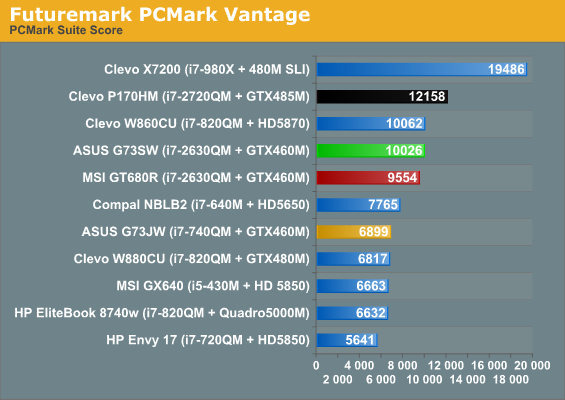
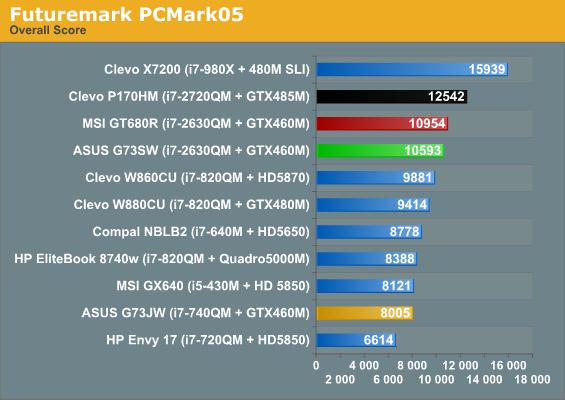
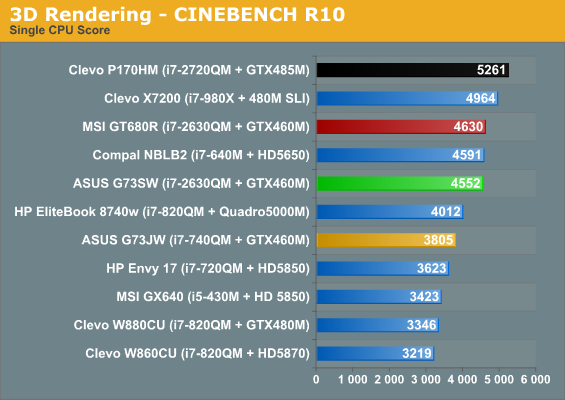
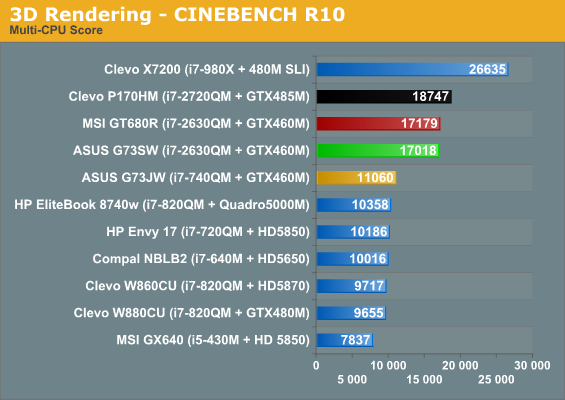
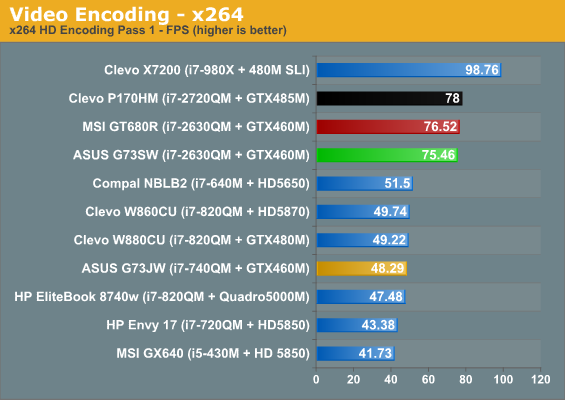
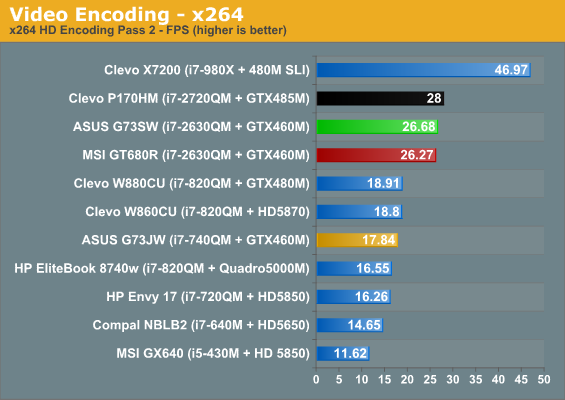
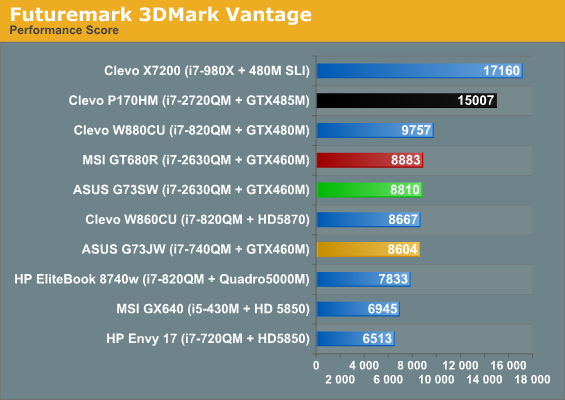

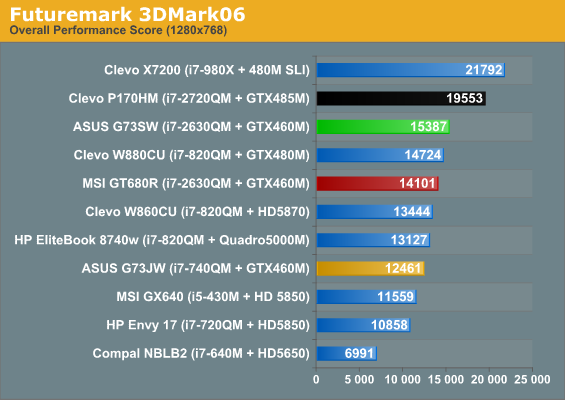
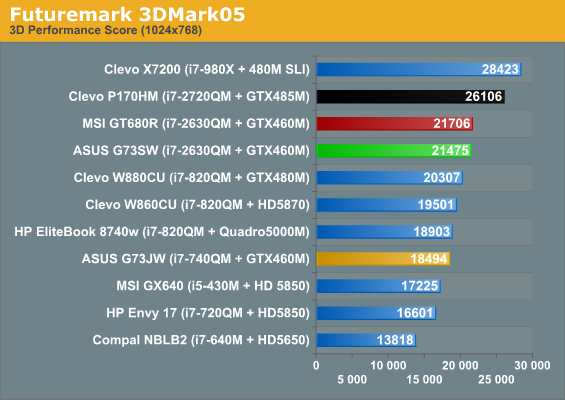
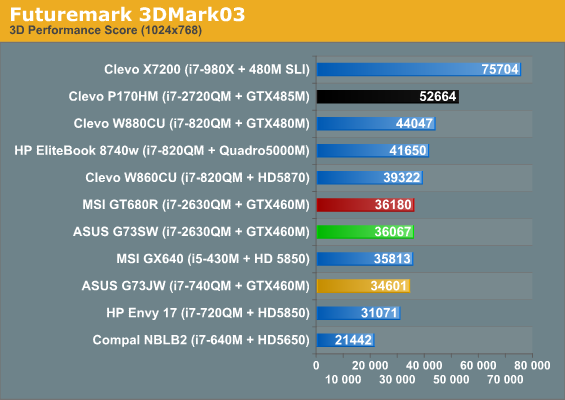
So the first point of interest is just how much faster the G73SW is compared to the G73JW. It leads by 45% in PCMark Vantage (and that’s without an SSD), 32% in the older PCMark05, and anywhere from 20% in the single-threaded Cinebench results to as much as 58% in the multi-threaded tests. In fact, all of the heavily threaded benchmarks are at least 50% faster with Sandy Bridge. Wow. But we already knew that. What about some more recent competition?
MSI’s GT680R has pretty much the same specs, only with RAID0 HDDs instead of individual drives. Oddly enough, the G73SW still came out slightly ahead in PCMark Vantage (by 5%), a test that’s particularly kind to fast storage subsystems (particularly SSDs). PCMark05 puts the GT680R ahead by a similar margin (3.5%), but Vantage is arguably more pertinent in today’s market. Elsewhere, the comparison is largely a wash, with MSI winning three, ASUS winning two, and a tie in the final test. All of the margins of victory are close enough to call it a tie. So, despite having a larger (and ostensibly cooler running) chassis, the G73SW delivers about the same performance as that of the GT680R, which is still very good.
The other point of comparison is the recent Clevo P170HM, which has a faster i7-2720QM CPU and a much faster GTX 485M GPU. The latter mostly won’t matter here (except for PCMark05), but the 2720QM does carry a small clock speed advantage, and the Crucial C300 SSD will definitely help in PCMark Vantage—good for a 21% lead, in fact. it has an 18% lead in PCMark05, with help from both the SSD and GPU. The remaining tests are purely CPU limited, and the lead ranges from 3-5% in x264 encoding to as much as 15% in the single-threaded Cinebench result where the more aggressive Turbo Boost on the 2720QM comes into play.
Recall that the 2720QM can Turbo to 3.3GHz from the stock 2.2GHz for single-threaded work, and still hit as high as 3.0GHz with all four cores active; in contrast, the 2630QM maxes out at 2.9GHz single-threaded, or 2.6GHz for all four cores. It looks as though x264 encoding isn’t able to Turbo as high as Cinebench for some reason, as even the heavily CPU bottlenecked second pass is still only 5% faster with the 2720QM, despite a potential 10% to 15% clock speed advantage—or maybe it’s that the G73SW is able to run at the maximum 2.6GHz, whereas the P170HM might have to drop down to 2.7-2.8GHz due to temperature.
Any way you slice it, the quad-core Sandy Bridge processors are very fast for general computing work. It’s just a shame that the use of the PM67 chipset and discrete GPU means there’s no way to access the CPU’s QuickSync feature. That’s one more reason switchable graphics really makes sense in notebooks, but it does add some complexity that some of the OEMs prefer to avoid. So far, no one has been willing to try NVIDIA’s Optimus Technology with any mobile GPU faster than the GT 435M, although we hear there’s a GT 555M Optimus notebook coming some time in 1H’11.










56 Comments
View All Comments
parthgh - Friday, March 4, 2011 - link
" So far, no one has been willing to try NVIDIA’s Optimus Technology with any mobile GPU faster than the GT 435M, although we hear there’s a GT 555M Optimus notebook coming some time in 1H’11."I guess XPS 17 has already launched and has Optimus enabled (apart from the 3D version).
Also the XPS 17 before SB revision had GT 445M with optimus enabled.
JarredWalton - Friday, March 4, 2011 - link
Still not faster than 460M... I didn't realize Dell upped the XPS 17 to the GT 555M, though. Interesting, and something I'll try to get them to send me now. Thank goodness they're now doing Optimus on all GPUs!Someone above asked about how they compare in performance, though. 460M has 192 cores at 675MHz with 2500MHz (effective) RAM. 555M has 144 cores at 590MHz with 1800MHz (effective) RAM. Note that 460M uses GDDR5 by default where the 555M goes with DDR3 by default. So the net result is 460M has 52.5% more computational power and 38.9% more memory bandwidth. I'd say GT 555M will be good for medium detail at 1080p, or high detail at 900p (give or take).
Drooosh - Saturday, March 5, 2011 - link
FYI - They won't allow you to get the good 1080P screen with Optimus. For some reason if you get the 1080P screen they force you to have it configured for 3D/120Hz which requires the 555M be enabled full time and thus no Optimus.I would bet that most customers are like me and would prefer Optimus over 3D. If they gave me FHD, 555M, and Optimus, I would by now.
Jarred, do you know of anyone that will have 555M or better switchable graphics, 1080P, and a backlit keyboard in a 15 or 17"? Lenovo or MSI may have thiese soon it appears?
JarredWalton - Saturday, March 5, 2011 - link
Right now, I'm not aware of anything like that. I don't know why Dell insists on doing weird things like killing Optimus support with certain upgrades. Perhaps Optimus doesn't work quite right with 3D at present? Heck, I'd just as soon skip all the 3D notebooks--the 120Hz panel is fine, but 3D just doesn't do anything for me.I've asked my NVIDIA contacts if there are any current/upcoming laptops with your above feature list. I've also asked them why no one appears to be willing to use Optimus with 460M or better. We'll see if they respond with any useful information. :-)
bennyg - Monday, March 7, 2011 - link
I heard rumours it's the way Optimus works sending the data from GPU to onboard gfx, the sheer amount of data pushed from high-end GPU to iGPU saturates that link, so midrange is OK but high-end suffers bigtime performance issuesIt does seem ridiculous that every SB laptop has the hardware to run ridiculous battery life (sans GPU of course) but not the drivers to allow it.
I don't care about Optimus and profiles. Give me a switch or a combo box and that will be better since I'll be in control not some numbskill algorithm. Just give me switching already!!!
strikeback03 - Friday, March 4, 2011 - link
In the Futuremark 3DMark Vantage Performance Score table on page 2 you have the wrong MSI laptop highlighted red.In the previous reviews I somehow missed how massive this laptop is, this time I noticed what a small portion of the chassis the 75WHr battery takes.
JarredWalton - Friday, March 4, 2011 - link
Thanks - the 3DMark Vantage chart is now correct. Also, I've added two more pictures to the gallery, this time with a tape measure in place. You can see the diagonal of the G73 chassis is about 20 inches (in a 17.3"-screen chassis...), and the Compal SNB unit we looked at in December also has a 17.3" LCD but the chassis is almost an inch smaller on the diagonal (and it's still got a lot of extra room for the large hinge). I'd like to see a 17.3" LCD in a chassis that's no more than 18.5", but I doubt that will happen.NaterGator - Friday, March 4, 2011 - link
As a G73SW owner I can absolutely 100% promise you this thing does not have an eSATA port anywhere to be found.Look over the unit they sent you again, but in the production unit I got from Amazon over a month ago there is most assuredly no eSATA. It is the only thing that frustrates me about this laptop, but the USB3.0 port makes up for it.
NaterGator - Friday, March 4, 2011 - link
Also, the screen flickering issue is a known bug with the nVidia drivers.Downgrade them to a 265 version and the flickering will stop.
JarredWalton - Friday, March 4, 2011 - link
I don't have that flickering problem on any other NVIDIA based laptops, though. Maybe it's localized to the G73SW for some reason? Anyway, you're correct about eSATA. Sorry for the error.